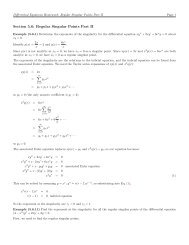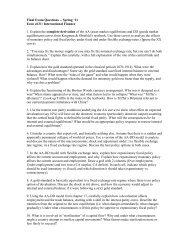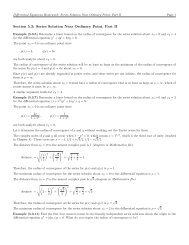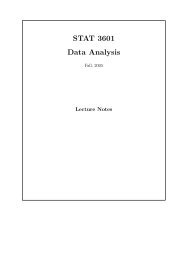Designing Efficient Snow Plow Routes - University of Minnesota
Designing Efficient Snow Plow Routes - University of Minnesota
Designing Efficient Snow Plow Routes - University of Minnesota
You also want an ePaper? Increase the reach of your titles
YUMPU automatically turns print PDFs into web optimized ePapers that Google loves.
A Bit <strong>of</strong> Graph Theory<br />
The main concepts from discrete and combinatorial mathematics that were used to solve this<br />
problem come from graph theory and applications. To make this paper self-contained, we will<br />
give a brief introduction to graph theory and touch upon terminology that pertains to this project.<br />
For an in-depth coverage <strong>of</strong> graph theory, good references are Bondy and Murty [2] and West<br />
[3].<br />
A graph, denoted, G=(V,E), is a pair (V,E) where V is a set <strong>of</strong> vertices and E is a set <strong>of</strong><br />
two-element subsets <strong>of</strong> V called edges (E { (i,j): i,j V }). We will now define a few structural<br />
terms in a graph, G=(V,E). Refer to Figure 2.6.2 for an example.<br />
Figure 2.6.2 An example <strong>of</strong> a graph G=(V,E)<br />
For v V, an edge <strong>of</strong> the type (v,v) is called a loop. If u,v V where u v then (u,v) and<br />
(u,v) are called parallel edges. The degree <strong>of</strong> a vertex is the number <strong>of</strong> edges incident to the<br />
vertex, with a loop counting twice. A graph G is simple if it contains no loops and no parallel<br />
edges. A walk from vertex v0 to vertex vk is a finite sequence v0,e1,v1,e2,v2,,ek,vk, where each vi<br />
V for i=0,1,2,,k and each ei (vi1,vi) E for i=1,2,,k. A trail from vertex v0 to vertex vk is<br />
a walk from vertex v0 to vertex vk which contains no repeated edges, while a path from vertex v0<br />
to vertex vk is a trail from vertex v0 to vertex vk which contains no repeated vertices. Examples <strong>of</strong><br />
a trail and a path from vertex 4 to vertex 1 in Figure 2.6.2 are 4,f,1,a,1,b,2,h,3,l,5,d,6,m,3,g,1 and<br />
4,e,6,m,3,g,1, respectively. A tour is a trail from vertex v0 to vertex v0 and a cycle is a trail from<br />
vertex v0 to vertex v0 which contains no other repeated vertices. A graph G=(V,E) is said to be<br />
connected if there exists a path between any two vertices u,v V.<br />
Optimal Eulerization <strong>of</strong> a Graph<br />
We will now describe how to model the efficient snow plow routes design as an<br />
optimization problem on a graph. First, based on each snow plow's designation area on the map<br />
in Figure 2.6.1, we construct a graph G=(V,E) by creating a vertex for each possible intersection.<br />
An edge is added between two vertices (intersections) if the block between the two intersections













